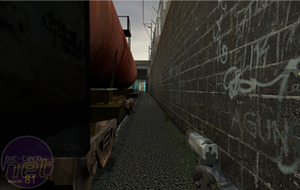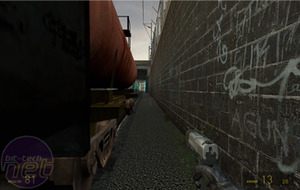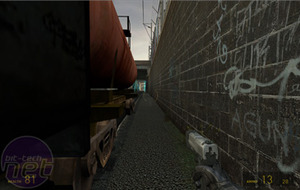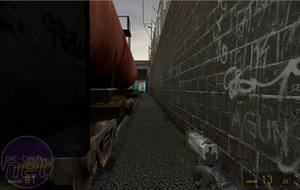Filtering Quality:
The antialiasing quality on both ATI and NVIDIA hardware is something that has remained the same for some time now and it's horses for courses, generally speaking. If you want a detailed break down in antialiasing quality, we suggest that you look at our Radeon X1800XL review.The major difference in image quality between the two hardware vendors is the filtering quality, and it's something that we want to make a point of highlighting here. As things get even more complex, the picture that you see on the screen can be incredibly different in some areas. It's almost like looking at red and green. As you know, we moved away from comparing apples to apples in October 2004, and we've stuck to our guns in providing you with information that is relevant to the gaming hardware enthusiast.


NVIDIA 16xAF ("Quality" driver setting) (2.37MB) / NVIDIA 16xAF ("High Quality" driver setting) (2.37MB)
When the high quality driver setting is switched on, the filtering quality improves somewhat - the mip boundaries can still be seen, but they're very subtle. There is still a weird-shaped area of the scene that isn't getting filtering at all - we think that this is to do with the angle-dependant filtering algorithm that NVIDIA is using in its hardware. This is unlikely to disappear until they modify their filtering hardware.
With ATI's default anisotropic filtering quality, it's possible to see the mip boundaries and we feel that the quality is not quite as good as NVIDIA's high quality driver setting. Also, the rather weird shaped area of the scene that isn't filtered is still present at the default settings. However, when the image quality is increased by using ATI's high quality anisotropic filtering option, the algorithm picks up the strange unfiltered area and applies anisotropic filtering to it. This results in a much crisper image on the screen.
Of course, the differences in quality aren't always quite as bad as this, but there are areas - mainly when the developer has used a gravel or pebble texture - where texture shimmering and over-optimisation is apparent. ATI are guilty of this too to some extent, but most of the filtering issues disappear when high quality anisotropic filtering is enabled.

MSI MPG Velox 100R Chassis Review
October 14 2021 | 15:04








Want to comment? Please log in.